#commercial lunar payload services (CLPS)
Text


The United States has returned to the lunar surface for the first time in more than 50 years after a privately-built spacecraft named Odysseus capped a nail-biting 73-minute descent from orbit with a touchdown near the moon’s south pole.
Amid celebrations of what NASA hailed “a giant leap forward,” there was no immediate confirmation of the status or condition of the lander, other than it had reached its planned landing site at crater Malapert A.
But later Intuitive Machines, the Texas-based company that built the first commercial craft to land on the moon, said the craft was “upright and starting to send data.”
The statement on X said mission managers were “working to downlink the first images from the lunar surface.”
The so-called “soft landing” on Thursday, which Steve Altemus, the company’s founder, had given only an 80% chance of succeeding, was designed to open a new era of lunar exploration as NASA works towards a scheduled late-2026 mission to send humans back there.
“Welcome to the moon,” Altemus said when touchdown when the 5.23pm touchdown was eventually confirmed, after about 10 minutes in which Odysseus was out of contact.
It was the first time any US-built spacecraft had landed on the moon since NASA’s most recent crewed visit, the Apollo 17 mission in December 1972, and the first visit by commercial vehicle following last month’s failure of Peregrine One, another partnership between the space agency and a private company, Astrobotic.
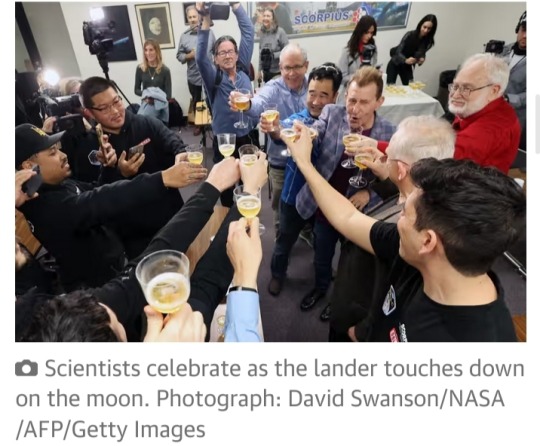
“Today, for the first time in more than a half century, the US has returned to the moon. Today, for the first time in the history of humanity, a commercial company, an American company, launched and led the voyage up there,” Bill Nelson, the NASA administrator, said.
“What a triumph. Odysseus has taken the moon. This feat is a giant leap forward for all of humanity.”
There was no video of Odysseus’s fully autonomous descent, which slowed to about 2.2mph at 33ft above the surface.
But a camera built by students at Florida’s Embry-Riddle Aeronautical University was designed to fall and take pictures immediately before touchdown, and NASA cameras were set to photograph the ground from the spacecraft.
The 14ft (4.3 metres) hexagonal, six-legged Nova-C lander, affectionately nicknamed Odie by Intuitive Machines employees, is part of NASA’s commercial lunar payload services (CLPS) initiative in which the agency awards contracts to private partners, largely to support the Artemis program.
NASA contributed $118m to get it off the ground, with Intuitive Machines funding a further $130m ahead of its February 15 launch from Florida’s Kennedy Space Center on a Falcon 9 rocket from Elon Musk’s SpaceX company.

The IM-1 mission, like the doomed Peregrine effort, is carrying a payload of scientific equipment designed to gather data about the lunar environment, specifically in the rocky region chosen as the landing site for NASA’s crewed Artemis III mission planned for two years’ time.
It is a hazardous area – “pockmarked with all of these craters,” according to Nelson – but chosen because it is believed to be rich in frozen water that could help sustain a permanent lunar base crucial to future human missions to Mars.
Scientists announced last year that they believed tiny glass beads strewn across the moon’s surface contained potentially “billions of tonnes of water” that could be extracted and used on future missions.
The risks are worth it, Nelson told CNN on Thursday, “to see if there is water in abundance. Because if there’s water, there’s rocket fuel: hydrogen, and oxygen. And we could have a gas station on the south pole of the moon.”
The planned operational life of the solar powered lander is only seven days, before the landing site about 186 miles from the moon’s south pole moves into Earth’s shadow.
But NASA hopes that will be long enough for analysis of how soil there reacted to the impact of the landing.
Other instruments will focus on space weather effects on the lunar surface, while a network of markers for communication and navigation will be deployed.
“Odysseus, powered by a company called Intuitive Machines, launched upon a SpaceX rocket, carrying a bounty of NASA scientific instruments, is bearing the dream of a new adventure in science, innovation, and American leadership in space,” Nelson said.
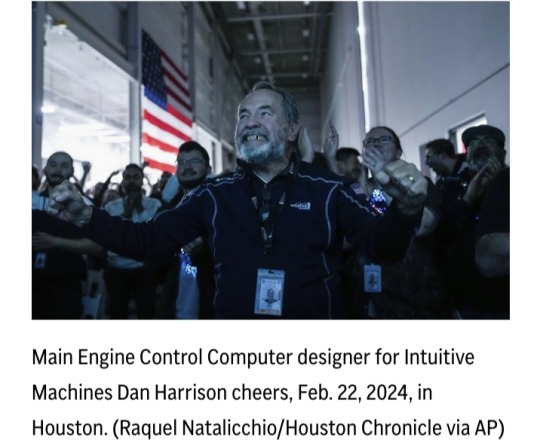
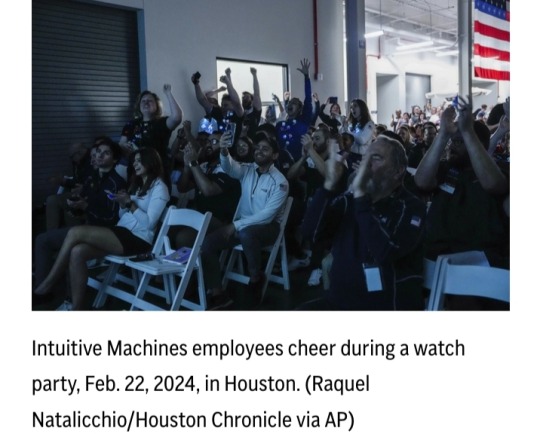
Through Artemis, NASA’s return-to-the-moon program that also has longer-term visions of crewed missions to Mars within the next two decades, the US seeks to stay ahead of Russia and China, both of which are planning their own human lunar landings.
Only the US has previously landed astronauts in six Apollo missions between 1969 and 1972, while five countries have placed uncrewed spacecraft there.
Japan joined the US, Russia, China, and India last month when its Smart Lander for Investigating the Moon (Slim) made a successful, if awkward touchdown after a three-month flight.
Two further Intuitive Machines launches are scheduled for later this year, including an ice drill to extract ingredients for rocket fuel, and another Nova-C lander containing a small Nasa rover and four small robots that will explore surface conditions.
https://www.theguardian.com/science/2024/feb/22/us-moon-landing-odysseus-intuitive-machines
youtube
US returns to lunar surface with for first time in over 50 years
23 February 2024
A spacecraft built and flown by Texas-based company Intuitive Machines landed near the south pole of the moon, the first US touchdown on the lunar surface in more than half a century, and the first ever achieved entirely by the private sector.
Communication with Odysseus seemed be lost during the final stages of the landing, leaving mission control uncertain as to the precise condition and position of the lander, according to flight controllers heard in the webcast.
US returns to lunar surface for first time in over 50 years: ‘Welcome to the moon.’
#Odysseus#Intuitive Machines#Youtube#NASA#Malapert A#moon#moon landing#spacecraft#Steve Altemus#lunar exploration#Bill Nelson#Nova-C lander#Odie#commercial lunar payload services (CLPS)#Artemis#Kennedy Space Center#Falcon 9#Elon Musk#SpaceX#IM-1 mission#Smart Lander for Investigating the Moon (SLIM)#lunar lander#earth
22 notes
·
View notes
Text
Intuitive Machines Nova-C
0 notes
Text
During the wee hours of Christmas Eve this year, before the gift wrapping begins and the aroma of gingerbread brightens the air, a spacecraft is set to launch to the moon.
It's called the Peregrine Lunar Lander, named for the fastest flying bird on Earth. If all goes to plan, the robotic avian will zoom through space and fly into the moon's gravitational tides, then meticulously lower its orbit until eventually touching down on a region of ancient lunar lava flows known as the Bay of Stickiness, or Sinus Viscositatis.
This mission will be one for the history books for several reasons, one of which is the fact it'll be the first to launch under NASA’s Commercial Lunar Payload Services (CLPS) initiative, created as a way for the agency to bring payloads to the moon without having to construct all the spacecraft necessary to bring those payloads there. In this case, the company Astrobiotic is behind the Peregrine lander and NASA's paying to stash a few things onboard.
Continue Reading.
122 notes
·
View notes
Text

NASA Artemis science, first intuitive machines flight head to moon
A suite of NASA science instruments and technology demonstrations is on the way to our nearest celestial neighbor for the benefit of humanity. Through this flight to the moon, they will provide insights into the lunar surface environment and test technologies for future landers and Artemis astronauts.
At 1:05 a.m. EST on Thursday, Intuitive Machines' Nova-C lander launched on a SpaceX Falcon 9 rocket from Launch Complex 39A at the agency's Kennedy Space Center in Florida. At approximately 1:53 a.m., the lander deployed from the Falcon 9 second stage. Teams confirmed it made communications contact with the company's mission operations center in Houston. The spacecraft is stable and receiving solar power.
These deliveries are part of NASA's CLPS (Commercial Lunar Payload Services) initiative and Artemis campaign, which includes new solar system science to better understand planetary processes and evolution, search for evidence of water and other resources, and support long-term human exploration.
"NASA scientific instruments are on their way to the moon—a giant leap for humanity as we prepare to return to the lunar surface for the first time in more than half a century," said NASA Administrator Bill Nelson. "These daring moon deliveries will not only conduct new science at the moon, but they are supporting a growing commercial space economy while showing the strength of American technology and innovation. We have so much to learn through CLPS flights that will help us shape the future of human exploration for the Artemis Generation."
While enroute to the moon, NASA instruments will measure the quantity of cryogenic engine fuel as it is used, and during descent toward the lunar surface, they will collect data on plume-surface interactions and test precision landing technologies.
Once on the moon, NASA instruments will focus on investigating space weather/lunar surface interactions and radio astronomy. The Nova-C lander also will carry retroreflectors contributing to a network of location markers on the moon for communication and navigation for future autonomous navigation technologies.
NASA science aboard the lander includes:
Lunar Node 1 Navigation Demonstrator: A small, CubeSat-sized experiment that will demonstrate autonomous navigation that could be used by future landers, surface infrastructure, and astronauts, digitally confirming their positions on the moon relative to other spacecraft, ground stations, or rovers on the move.
Laser Retroreflector Array: A collection of eight retroreflectors that enable precision laser ranging, which is a measurement of the distance between the orbiting or landing spacecraft to the reflector on the lander. The array is a passive optical instrument and will function as a permanent location marker on the moon for decades to come.
Navigation Doppler Lidar for Precise Velocity and Range Sensing: A Lidar-based (Light Detection and Ranging) guidance system for descent and landing. This instrument operates on the same principles of radar but uses pulses from a laser emitted through three optical telescopes. It will measure speed, direction, and altitude with high precision during descent and touchdown.
Radio Frequency Mass Gauge: A technology demonstration that measures the amount of propellant in spacecraft tanks in a low-gravity space environment. Using sensor technology, the gauge will measure the amount of cryogenic propellant in Nova-C's fuel and oxidizer tanks, providing data that could help predict fuel usage on future missions.
Radio-wave Observations at the Lunar Surface of the Photoelectron Sheath: The instrument will observe the moon's surface environment in radio frequencies, to determine how natural and human-generated activity near the surface interacts with and could interfere with science conducted there.
Stereo Cameras for Lunar Plume-Surface Studies: A suite of four tiny cameras to capture imagery showing how the moon's surface changes from interactions with the spacecraft's engine plume during and after descent.
Intuitive Machines' Nova-C-class lunar lander, named Odysseus, is scheduled to land on the moon's South Pole region near the lunar feature known as Malapert A on Thursday, Feb. 22. This relatively flat and safe region is within the otherwise heavily cratered southern highlands on the side of the moon visible from Earth. Landing near Malapert A will also help mission planners understand how to communicate and send data back to Earth from a location where Earth is low on the lunar horizon.
The NASA science aboard will spend approximately seven days gathering valuable scientific data about Earth's nearest neighbor, helping pave the way for the first woman and first person of color to explore the moon under Artemis.
IMAGE....A SpaceX Falcon 9 rocket carrying Intuitive Machines’ Nova-C lunar lander lifts off from Launch Pad 39A at NASA’s Kennedy Space Center in Florida at 1:05 a.m. EST on Feb. 15, 2024. As part of NASA’s CLPS (Commercial Lunar Payload Services) initiative and Artemis campaign, Intuitive Machines’ first lunar mission will carry NASA science and commercial payloads to the moon to study plume-surface interactions, space weather/lunar surface interactions, radio astronomy, precision landing technologies, and a communication and navigation node for future autonomous navigation technologies. Credit: NASA
11 notes
·
View notes
Text
NASA contract Firefly to provide radio frequency calibration services from lunar orbit
Cedar Park TX (SPX) Sep 15, 2023
Firefly Aerospace, Inc., an end-to-end space transportation company, was awarded an $18 million NASA Commercial Lunar Payload Services (CLPS) contract to provide radio frequency calibration services from lunar orbit as part of Blue Ghost Mission 2, Firefly's second mission to the Moon in 2026. This contract marks Firefly's third NASA CLPS task order award, totaling nearly $230 million to date fo
Full article>>
21 notes
·
View notes
Link
Washington (AFP) Feb 21, 2024 The year 2024 promises to be a busy one for American Moon landings, all under a new partnership between NASA and the space industry. A first attempt under the Commercial Lunar Payload Services (CLPS) initiative ended in disappointing failure last month, but a second, led by Houston-based Intuitive Machines, will attempt on Thursday to return the United States to Moon for the first time in fi
3 notes
·
View notes
Text
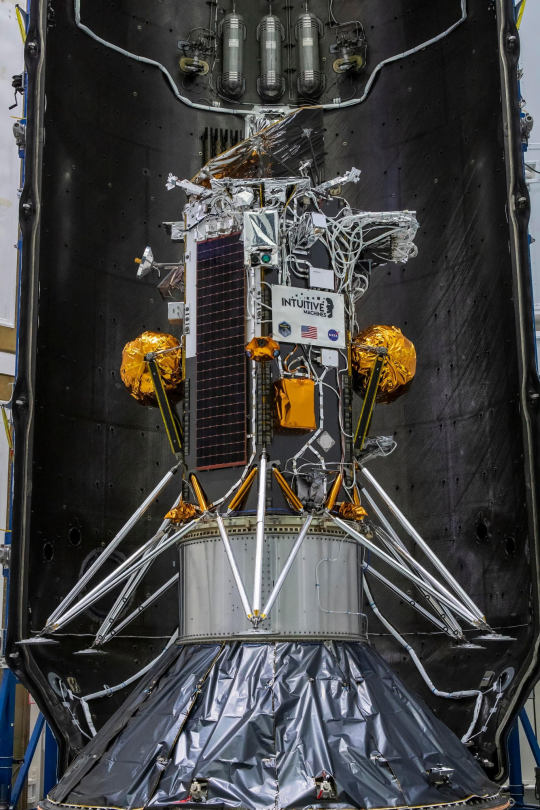
O módulo lunar Nova-C está encapsulado na carenagem de um foguete SpaceX Falcon 9 em preparação para o lançamento, como parte da iniciativa CLPS (Commercial Lunar Payload Services) da NASA e da campanha Artemis
#fotos#tumblr#welberfotos#postar#photos#welberdesignershop#photo#foto#NASA#Espaço sideral#Mundo#Work#Word
4 notes
·
View notes
Text
The Marshall Star for February 28 2024
NASA Tech Contributes to Soft Moon Landing For the first time in more than 50 years, new NASA science instruments and technology demonstrations are operating on the Moon following the first successful delivery of the agency’s CLPS (Commercial Lunar Payload Services) initiative. Intuitive Machines’ Nova-C lander, called Odysseus, completed a seven-day journey to lunar orbit […]
from NASA https://ift.tt/rO6huoC
2 notes
·
View notes
Text
O provedor comercial de serviços de entrega lunar da NASA, Intuitive Machines, lançará seu módulo lunar Nova-C no final deste mês, que transportará várias cargas úteis de ciência e tecnologia da NASA, incluindo o Navigation Doppler Lidar (NDL).
A missão Artemis levará os humanos de volta à Lua, e o Navigation Doppler Lidar garantirá um pouso seguro para todos a bordo. Este sistema de orientação de última geração, desenvolvido pelo Langley Research Center da NASA, tem o potencial de revolucionar a forma como as naves espaciais pousam em mundos extraterrestres.
O sistema de orientação usa pulsos de laser para medir a velocidade e a distância com precisão. A NASA demonstrará as capacidades do NDL no ambiente lunar durante a missão IM-1.
Embora o NDL seja uma carga útil da NASA para a entrega do CLPS (Commercial Lunar Payload Services) da Intuitive Machines, ele não é considerado de missão crítica para o pouso bem-sucedido do Nova-C, já que a Intuitive Machines possui seus próprios sistemas de navegação e pouso.
A história do NDL aparentemente remonta a quase 20 anos atrás, quando o Dr. Farzin Amzajerdian, então gerente de projeto da NASA Langley, fez uma descoberta notável. Ele encontrou uma maneira precisa de pousar rovers em Marte, o que era um desafio significativo na época devido a várias dificuldades técnicas.
Por exemplo, o radar não era uma solução eficaz para este propósito, uma vez que as ondas de rádio não conseguiam cobrir com precisão todas as áreas necessárias na superfície marciana. Consequentemente, crateras e rochas menores poderiam passar despercebidas, representando perigos inesperados para os módulos de aterrissagem.
"Os pousadores precisavam do sensor de radar para saber a que distância estavam do solo e a que velocidade se moviam, para que pudessem cronometrar o lançamento do paraquedas", disse Amzajerdian. "Muito cedo ou muito tarde, o módulo de pouso erraria o alvo ou cairia na superfície."
As ondas de rádio também não conseguiam medir a velocidade e o alcance independentemente umas das outras, o que é importante, segundo Aram Gragossian, que se juntou à equipe há cerca de seis anos.
"Por que não usar um lidar em vez de um radar?" ele perguntou.
A tecnologia LiDAR (detecção e alcance de luz) usa luz visível ou infravermelha, semelhante à forma como o radar usa ondas de rádio. O LiDAR envia pulsos de laser para um alvo, que reflete parte dessa luz de volta para um detector. Graças ao efeito Doppler, o LiDAR pode medir a velocidade de forma direta e precisa à medida que se move em relação ao seu alvo. A distância é medida com base no tempo de viagem da luz até o alvo e vice-versa.
Comparado ao radar, o LiDAR oferece diversas vantagens, incluindo o fato de que um laser transmite um feixe de luz em forma de lápis, o que pode fornecer uma medição mais precisa e precisa.
Enquanto a NDL se prepara para embarcar em sua missão lunar, a NASA já está trabalhando em um sistema de próxima geração. A equipe está desenvolvendo um sensor complementar ao NDL, que é uma câmera Flash Lidar multifuncional que pode examinar o terreno circundante mesmo na escuridão total. Quando combinado com NDL, Flash Lidar permitirá que você vá "a qualquer lugar, a qualquer hora".
Outras versões futuras do NDL poderiam ter usos fora do complicado negócio de pousar em superfícies extraterrestres. Na verdade, eles podem ter utilidade em um ambiente muito terrestre, como ajudar carros autônomos a navegar pelas ruas e rodovias locais.
0 notes
Text
La NASA estudiará los efectos del ruido de radio en la ciencia lunar: un nuevo campo de investigación
En febrero de 2024, la misión IM-1 de Intuitive Machines se lanzará a la región del Polo Sur de la Luna, como parte de la iniciativa Commercial Lunar Payload Services , o CLPS, de la NASA. Esta misión es parte del esfuerzo continuo de CLPS para reducir el costo de las investigaciones científicas y las demostraciones tecnológicas que van a la Luna y hacerlas más rutinarias en el período previo a…
View On WordPress
#artemis#aterrizaje humano#ciencias espaciales#Comunicación#Desarrollo#Estudios#futuro#Investigaciones#Maquinas intuitivas#Nova-C#Nuevos#Ondas de radio#Rolses
0 notes
Text
NASA, Intuitive Machines to Discuss Historic Moon Mission Today
New Post has been published on https://petn.ws/VGJqy
NASA, Intuitive Machines to Discuss Historic Moon Mission Today
NASA and Intuitive Machines will host a televised news conference at 5 p.m. EST Friday, Feb. 23, to detail the Odysseus lander’s historic soft Moon landing. With the last-minute assistance of a NASA precision landing technology, the first CLPS, or Commercial Lunar Payload Services, mission carrying the agency’s science and technology demonstrations successfully landed on […]
See full article at https://petn.ws/VGJqy
#OtherNews
0 notes
Text
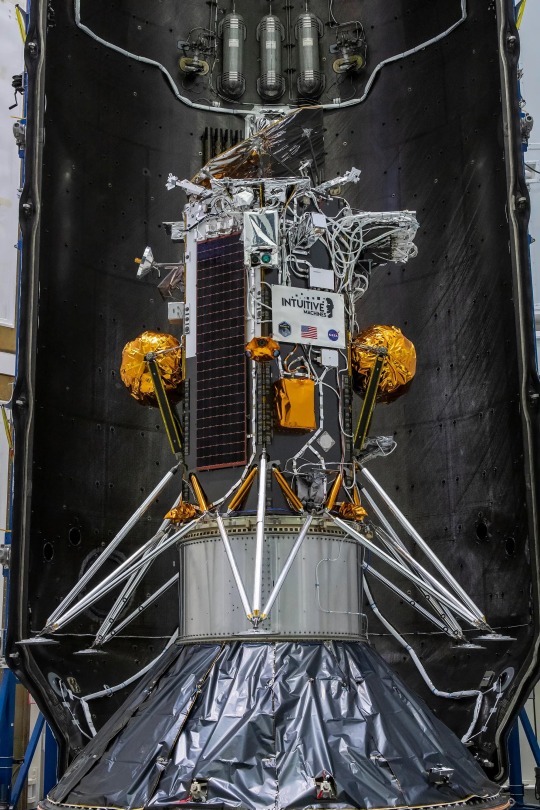
IM-1 Nova-C 'Odysseus' entered a 92km Lunar orbit today (21 Feb) after a long braking burn of 408 seconds, reducing its velocity by some 800m/sec. Nominally Odysseus will perform 12 orbits with a period of 2 hours before entering a descent orbit of 10 x 92km before attempting the landing tomorrow.
Landing is currently scheduled for 22:49GMT with coverage on NASA TV from 21:00GMT. If successful it will be the first US spacecraft to land on the Moon since Apollo 17 on 19 December 1972, it is also the second of NASA's Commercial Lunar Payload Service missions, CLPS-2 (where NASA pays commercial companies to deliver things to the Moon in support of the Artemis program). CLPS-1 was the Astrobotic's Peregrine mission which failed due to springing a propellent tank leak after launch. Pic: Intuitive Machines/SpaceX/NASA... IM-1 during encapsulation, the gold tanks are for helium for the altitude rockets, the main engine is powered by methane and liquid oxygen (a first for a moon lander)
1 note
·
View note
Text
Новости Сиэтла - 17-02-2024
Окончательный подсчет НАСА показывает, что космический аппарат вернул в два раза больше обломков астероида.
Космический аппарат НАСА «Осирис-Рекс» превзошел ожидания, вернув вдвое больше обломков астероида Бенну, чем планировал. Космический аппарат собрал 121,6 грамма пыли и гальки, что является самым крупным космическим уловом из-за пределов Луны. Образцы, богатые углеродом, впервые были собраны НАСА с астероида и сейчас хранятся в специальной лаборатории в Хьюстоне. Несмотря на некоторые трудности с застрявшими креплениями, что затянуло процесс открытия контейнера с образцами, миссия была успешной. Теперь космический аппарат направляется к другому космическому камню для пролета мимо него без сбора образцов.
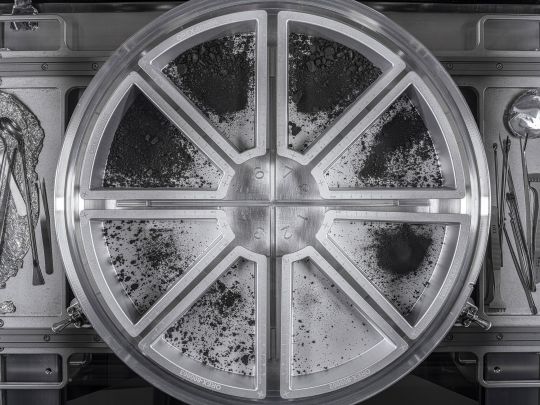
Источник: https://www.seattletimes.com/seattle-news/science/nasas-final-tally-shows-spacecraft-returned-double-the-amount-of-asteroid-rubble/
Стюардесса, которая спасла 6 яиц фламинго, позже встречает птенцов.
В Сиэтле произошла трогательная история, когда стюардесса Alaska Airlines по имени Эмбер Мэй была попросена помочь сохранить теплоту шести нежных яиц чилийских фламинго во время рейса из Атланты в Сиэтл. Инкубатор, в котором яйца транспортировала сотрудница зоопарка, вышел из строя, поставив под угрозу судьбу яиц. Мэй с помощью пассажиров создала импровизированное гнездо, используя теплые перчатки, наполненные теплой водой, чтобы обеспечить выживание яиц. Спасительные действия и доброта Мэй и пассажиров оказались успешными, и четыре самки и два самца успешно вылупились в зоопарке Woodland Park в Сиэтле. Эти новые прибавления имеют важное значение для популяции фламинго в зоопарке, способствуя их репродуктивному успеху. Чилийские фламинго являются видом, который находится под угрозой и сталкивается с проблемами, такими как потеря среды обитания, загрязнение и незаконное собирательство яиц. Зоопарк надеется, что эти новые фламинго привлекут внимание к усилиям по сохранению и помогут увеличить популяцию стада, особенно учитывая, что многие старые фламинго больше не размножаются. Этот трогательный случай не только спас жизни птенцам фламинго, но также подчеркнул важность защиты этих красивых птиц.

Источник: https://www.seattletimes.com/seattle-news/flight-attendant-who-saved-6-flamingo-eggs-later-meets-chicks/
SpaceX запус��ает то, что может стать первым успешным коммерческим лунным посадочным модулем.
В Сиэтле компания SpaceX успешно запустила ракету Falcon 9 с лунным посадочным модулем Nova-C компании Intuitive Machines под названием Одиссей в рамках миссии IM-1. Ракета взлетела с площадки 39-A Центра космических полетов имени Кеннеди после задержки из-за проблем с загрузкой криогенного метана. Цель миссии - достичь первой коммерческой мягкой посадки на Луну с запланированным прибытием 22 февраля. Первая ступень совершила свой 18-й полет и приземлилась на станции Военно-космических сил на мысе Канаверал. Этот запуск стал девятым и десятым орбитальными полетами с космического побережья в 2024 году, преимущественно осуществляемыми SpaceX.
Посадочный модуль Nova-C успешно отделился от второй ступени и установил связь для ее транслунного ввода. Эта миссия является частью программы Commercial Lunar Payload Services (CLPS) НАСА, в рамках которой Intuitive Machines заключила контракт на три запуска. Посадочный модуль компании оборудован для перевозки 220 фунтов груза, причем шесть из 12 полезных нагрузок на борту направлены к южному полюсу Луны. Программа CLPS направлена на развитие лунной экономики через привлечение частных компаний для выполнения лунных миссий, что позволит НАСА сконцентрироваться на пилотируемых миссиях в рамках программы "Артемида".
Руководитель программы CLPS в NASA выразил оптимизм относительно успешности миссии Intuitive Machines, подчеркнув трудности посадки на Луну. Эта миссия является второй из пяти запланированных на 2024 год запусков CLPS, сразу за предыдущей попыткой Astrobotic Technology, столкнувшейся с трудностями. Успешная посадка Intuitive Machines станет значимым событием в частной космической деятельности, продемонстрировав возможности коммерческих структур в выполнении лунных миссий с минимальным вмешательством со стороны НАСА.
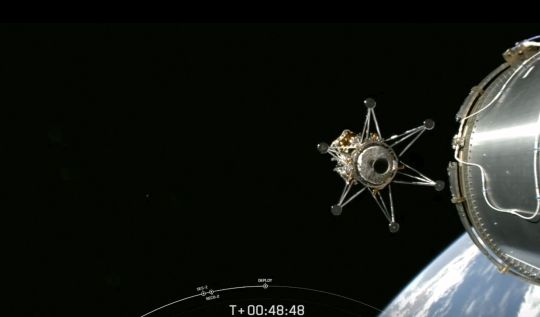
Источник: https://www.seattletimes.com/business/boeing-aerospace/spacex-launches-what-could-become-1st-successful-commercial-lunar-lander/
0 notes
Text

NASA's trio of mini rovers will team up to explore the Moon
Working together without direct human input, three rovers each the size of a carry-on bag will map the lunar surface in 3D, using cameras and ground-penetrating radar.
NASA is sending a trio of miniature rovers to the Moon to see how well they can cooperate with one another without direct input from mission controllers back on Earth. A teamwork-minded experiment to demonstrate new technology, the CADRE (Cooperative Autonomous Distributed Robotic Exploration) project marks another step the agency is taking toward developing robots that, by operating autonomously, can boost the efficiency of future missions. And, by taking simultaneous measurements from multiple locations, the rovers are meant to show how multirobot missions could potentially enable new science or support astronauts.
Currently slated to arrive aboard a lander in 2024 as part of NASA's CLPS (Commercial Lunar Payload Services) initiative, CADRE's three small rovers will be lowered onto the Reiner Gamma region of the Moon via tethers. Each about the size of a carry-on suitcase, the four-wheeled rovers will drive to find a sunbathing spot, where they'll open their solar panels and charge up. Then they'll spend a full lunar day - about 14 Earth days - conducting experiments designed to test their capabilities.
"Our mission is to demonstrate that a network of a mobile robots can cooperate to accomplish a task without human intervention - autonomously," said Subha Comandur, the CADRE project manager at NASA's Jet Propulsion Laboratory in Southern California. "It could change how we do exploration in the future. The question for future missions will become: 'How many rovers do we send, and what will they do together?'"
Mission controllers on Earth will send a broad directive to the rovers' base station aboard the 13-foot-tall (4-meter-tall) lander. Then the team of little robots will elect a "leader," which in turn will distribute work assignments to accomplish the collective goal. Each rover will figure out how best to safely complete its assigned task.
"The only instruction is, for example, 'Go explore this region,' and the rovers figure out everything else: when they'll do the driving, what path they'll take, how they'll maneuver around local hazards," said JPL's Jean-Pierre de la Croix, CADRE's principal investigator. "You only tell them the high-level goal, and they have to determine how to accomplish it."
Experiments in Teamwork
The rovers will face several tests - all within view of a monitoring camera on the base station atop the lander. The first is to drive in formation and stay on course using ultra-wideband radios to maintain their relative positions while relying on sensors to avoid obstacles. In a second experiment, the rovers will each take a path of their own choosing to explore a designated area of about 4,300 square feet (400 square meters), creating a topographic 3D map with stereo cameras. The project will also assess how well the team would adapt if a rover stopped working for some reason. Success will indicate that multirobot missions are a good choice for exploring hazardous but scientifically rewarding terrain.
And while CADRE isn't focused on conducting science, the rovers will be packing multistatic ground-penetrating radars. Driving in formation, each rover will receive the reflection of radio signals sent by the others, creating a 3D image of the structure of the subsurface as much as 33 feet (10 meters) below. Together they can gather more complete data than can current state-of-the-art ground-penetrating radars like the one on NASA's Perseverance Mars rover, RIMFAX (Radar Imager for Mars' Subsurface Experiment).
"We'll see how multiple robots working together - doing multiple measurements in different places at the same time - can record data that would be impossible for a single robot to achieve," Comandur said. "It could be a game-changing way of doing science."
Working Smart
But there's more to CADRE than testing autonomy and teamwork capabilities: The rovers also need to survive the harsh thermal environment near the Moon's equator, which poses a challenge for such small robots. In the searing sunlight, the rovers could face midday temperatures of up to 237 degrees Fahrenheit (114 Celsius). Made with a combination of commercial off-the-shelf parts and custom-built components, the rovers must be robust enough to make it through the daytime heat while being compact and lightweight.
At the same time, they need to have the computing power to run the JPL-developed cooperative autonomy software. It's a difficult balance: The project's rovers and base station get their brain power from a small processing chip (the next generation of the cellphone-class processor inside NASA's Ingenuity Mars Helicopter), but using the processor contributes to the heat.
To prevent the rovers from cooking, the CADRE team came up with a creative solution: 30-minute wake-sleep cycles. Every half-hour, the rovers will shut down, cooling off via radiators and recharging their batteries. When they simultaneously awaken, they'll share their health status with one another via a mesh radio network (much like a home Wi-Fi network) and once again elect a leader based on which is fittest for the task at hand. Then off they'll go for another round of lunar exploration.
11 notes
·
View notes
Link
A SpaceX Falcon 9 rocket carrying Intuitive Machines’ Nova-C lunar lander lifts off from Launch Pad 39A at NASA’s Kennedy Space Center in Florida at 1:05 a.m. EST on Feb. 15, 2024. As part of NASA’s CLPS (Commercial Lunar Payload Services) initiative and Artemis campaign, Intuitive Machines’ first lunar mission will carry NASA science and commercial payloads to the Moon to study plume-surface interactions, space weather/lunar surface interactions, radio astronomy, precision landing technologies, and a communication and navigation node for future autonomous navigation technologies. A suite of NASA science instruments and technology demonstrations is on the way to our nearest celestial neighbor for the benefit of humanity. Through this flight to the Moon, they will provide insights into the lunar surface environment and test technologies for future landers and Artemis astronauts. At 1:05 a.m. EST on Thursday, Intuitive Machines’ Nova-C lander launched on a SpaceX Falcon 9 rocket from Launch Complex 39A at the agency’s Kennedy Space Center in Florida. At approximately 1:53 a.m., the lander deployed from the Falcon 9 second stage. Teams confirmed it made communications contact with the company’s mission operations center in Houston. The spacecraft is stable and receiving solar power. These deliveries are part of NASA’s CLPS (Commercial Lunar Payload Services) initiative and Artemis campaign, which includes new solar system science to better understand planetary processes and evolution, search for evidence of water and other resources, and support long-term human exploration. “NASA scientific instruments are on their way to the Moon – a giant leap for humanity as we prepare to return to the lunar surface for the first time in more than half a century,” said NASA Administrator Bill Nelson. “These daring Moon deliveries will not only conduct new science at the Moon, but they are supporting a growing commercial space economy while showing the strength of American technology and innovation. We have so much to learn through CLPS flights that will help us shape the future of human exploration for the Artemis Generation.” While enroute to the Moon, NASA instruments will measure the quantity of cryogenic engine fuel as it is used, and during descent toward the lunar surface, they will collect data on plume-surface interactions and test precision landing technologies. Once on the Moon, NASA instruments will focus on investigating space weather/lunar surface interactions and radio astronomy. The Nova-C lander also will carry retroreflectors contributing to a network of location markers on the Moon for communication and navigation for future autonomous navigation technologies. NASA science aboard the lander includes: Lunar Node 1 Navigation Demonstrator: A small, CubeSat-sized experiment that will demonstrate autonomous navigation that could be used by future landers, surface infrastructure, and astronauts, digitally confirming their positions on the Moon relative to other spacecraft, ground stations, or rovers on the move. Laser Retroreflector Array: A collection of eight retroreflectors that enable precision laser ranging, which is a measurement of the distance between the orbiting or landing spacecraft to the reflector on the lander. The array is a passive optical instrument and will function as a permanent location marker on the Moon for decades to come. Navigation Doppler Lidar for Precise Velocity and Range Sensing: A Lidar-based (Light Detection and Ranging) guidance system for descent and landing. This instrument operates on the same principles of radar but uses pulses from a laser emitted through three optical telescopes. It will measure speed, direction, and altitude with high precision during descent and touchdown. Radio Frequency Mass Gauge: A technology demonstration that measures the amount of propellant in spacecraft tanks in a low-gravity space environment. Using sensor technology, the gauge will measure the amount of cryogenic propellant in Nova-C’s fuel and oxidizer tanks, providing data that could help predict fuel usage on future missions. Radio-wave Observations at the Lunar Surface of the Photoelectron Sheath: The instrument will observe the Moon’s surface environment in radio frequencies, to determine how natural and human-generated activity near the surface interacts with and could interfere with science conducted there. Stereo Cameras for Lunar Plume-Surface Studies: A suite of four tiny cameras to capture imagery showing how the Moon’s surface changes from interactions with the spacecraft’s engine plume during and after descent. Intuitive Machines’ Nova-C-class lunar lander, named Odysseus, is scheduled to land on the Moon’s South Pole region near the lunar feature known as Malapert A on Thursday, Feb. 22. This relatively flat and safe region is within the otherwise heavily cratered southern highlands on the side of the Moon visible from Earth. Landing near Malapert A will also help mission planners understand how to communicate and send data back to Earth from a location where Earth is low on the lunar horizon. The NASA science aboard will spend approximately seven days gathering valuable scientific data about Earth’s nearest neighbor, helping pave the way for the first woman and first person of color to explore the Moon under Artemis. Learn more about NASA’s CLPS initiative at: https://www.nasa.gov/clps -end- Karen Fox / Alise FisherHeadquarters, Washington202-358-1600 / [email protected] / [email protected] Nilufar RamjiJohnson Space Center, [email protected] Antonia JaramilloKennedy Space Center, [email protected] Share Details Last Updated Feb 15, 2024 LocationNASA Headquarters Related TermsMissionsArtemisCommercial Lunar Payload Services (CLPS)
3 notes
·
View notes
Text

O foguete SpaceX Falcon 9 transportando o módulo lunar Nova-C da Intuitive Machines decola da plataforma de lançamento 39A no Kennedy Space Center da NASA, na Flórida, às 1h05 EST em 15 de fevereiro de 2024. Como parte do CLPS (Commercial Lunar Payload Services) da NASA iniciativa e campanha Artemis, a primeira missão lunar da Intuitive Machines transportará cargas científicas e comerciais da NASA para a Lua para estudar interações pluma-superfície, clima espacial/interações superfície lunar, radioastronomia, tecnologias de pouso de precisão e um nó de comunicação e navegação para o futuro tecnologias de navegação autônoma.
#tumblr#fotos#welberfotos#postar#photos#welberdesignershop#photo#foto#cars#carros#Space#Espaço sideral
2 notes
·
View notes